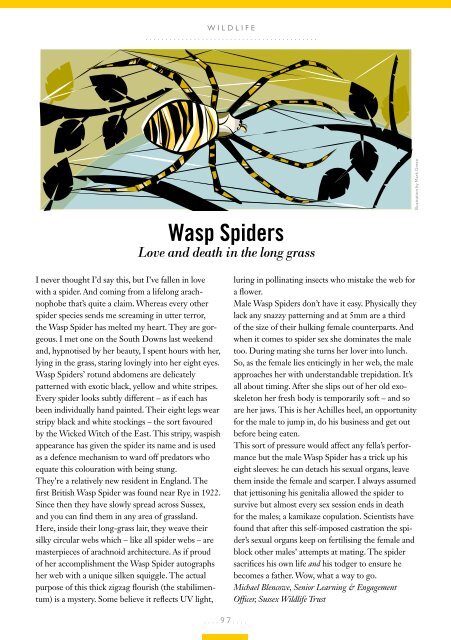Viva Brighton Issue #67 September 2018
Create successful ePaper yourself
Turn your PDF publications into a flip-book with our unique Google optimized e-Paper software.
WILDLIFE<br />
...........................................<br />
Wasp Spiders<br />
Love and death in the long grass<br />
Illustration by Mark Greco<br />
I never thought I’d say this, but I’ve fallen in love<br />
with a spider. And coming from a lifelong arachnophobe<br />
that’s quite a claim. Whereas every other<br />
spider species sends me screaming in utter terror,<br />
the Wasp Spider has melted my heart. They are gorgeous.<br />
I met one on the South Downs last weekend<br />
and, hypnotised by her beauty, I spent hours with her,<br />
lying in the grass, staring lovingly into her eight eyes.<br />
Wasp Spiders’ rotund abdomens are delicately<br />
patterned with exotic black, yellow and white stripes.<br />
Every spider looks subtly different – as if each has<br />
been individually hand painted. Their eight legs wear<br />
stripy black and white stockings – the sort favoured<br />
by the Wicked Witch of the East. This stripy, waspish<br />
appearance has given the spider its name and is used<br />
as a defence mechanism to ward off predators who<br />
equate this colouration with being stung.<br />
They’re a relatively new resident in England. The<br />
first British Wasp Spider was found near Rye in 1922.<br />
Since then they have slowly spread across Sussex,<br />
and you can find them in any area of grassland.<br />
Here, inside their long-grass lair, they weave their<br />
silky circular webs which – like all spider webs – are<br />
masterpieces of arachnoid architecture. As if proud<br />
of her accomplishment the Wasp Spider autographs<br />
her web with a unique silken squiggle. The actual<br />
purpose of this thick zigzag flourish (the stabilimentum)<br />
is a mystery. Some believe it reflects UV light,<br />
luring in pollinating insects who mistake the web for<br />
a flower.<br />
Male Wasp Spiders don’t have it easy. Physically they<br />
lack any snazzy patterning and at 5mm are a third<br />
of the size of their hulking female counterparts. And<br />
when it comes to spider sex she dominates the male<br />
too. During mating she turns her lover into lunch.<br />
So, as the female lies enticingly in her web, the male<br />
approaches her with understandable trepidation. It’s<br />
all about timing. After she slips out of her old exoskeleton<br />
her fresh body is temporarily soft – and so<br />
are her jaws. This is her Achilles heel, an opportunity<br />
for the male to jump in, do his business and get out<br />
before being eaten.<br />
This sort of pressure would affect any fella’s performance<br />
but the male Wasp Spider has a trick up his<br />
eight sleeves: he can detach his sexual organs, leave<br />
them inside the female and scarper. I always assumed<br />
that jettisoning his genitalia allowed the spider to<br />
survive but almost every sex session ends in death<br />
for the males; a kamikaze copulation. Scientists have<br />
found that after this self-imposed castration the spider’s<br />
sexual organs keep on fertilising the female and<br />
block other males’ attempts at mating. The spider<br />
sacrifices his own life and his todger to ensure he<br />
becomes a father. Wow, what a way to go.<br />
Michael Blencowe, Senior Learning & Engagement<br />
Officer, Sussex Wildlife Trust<br />
....97....


















